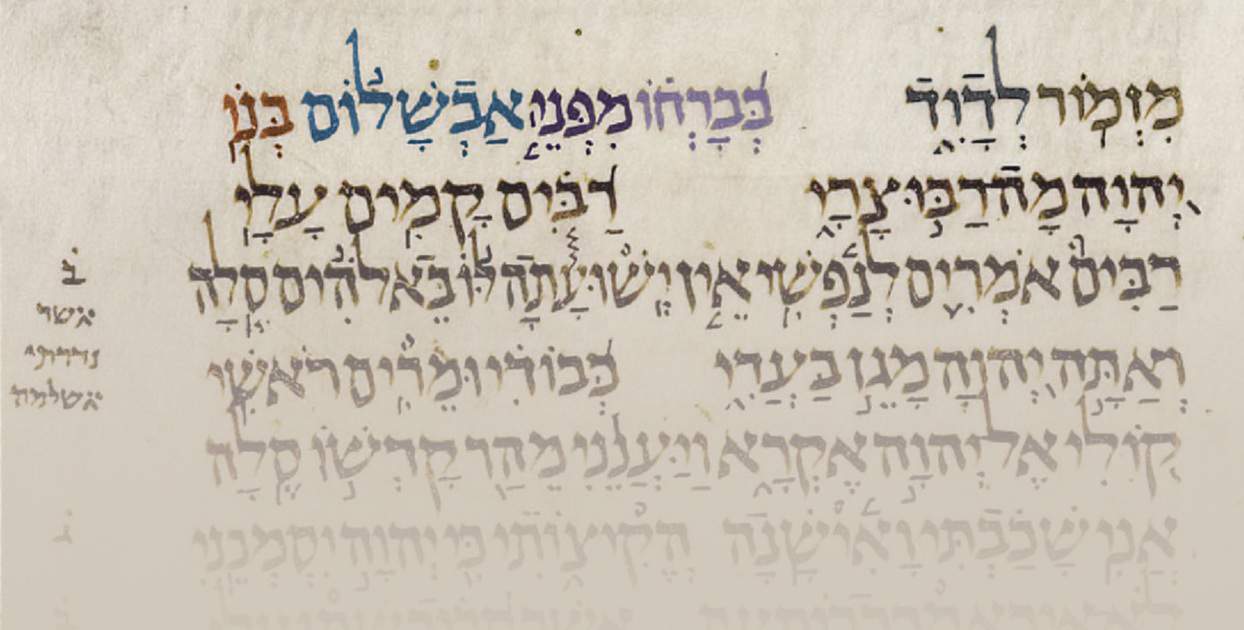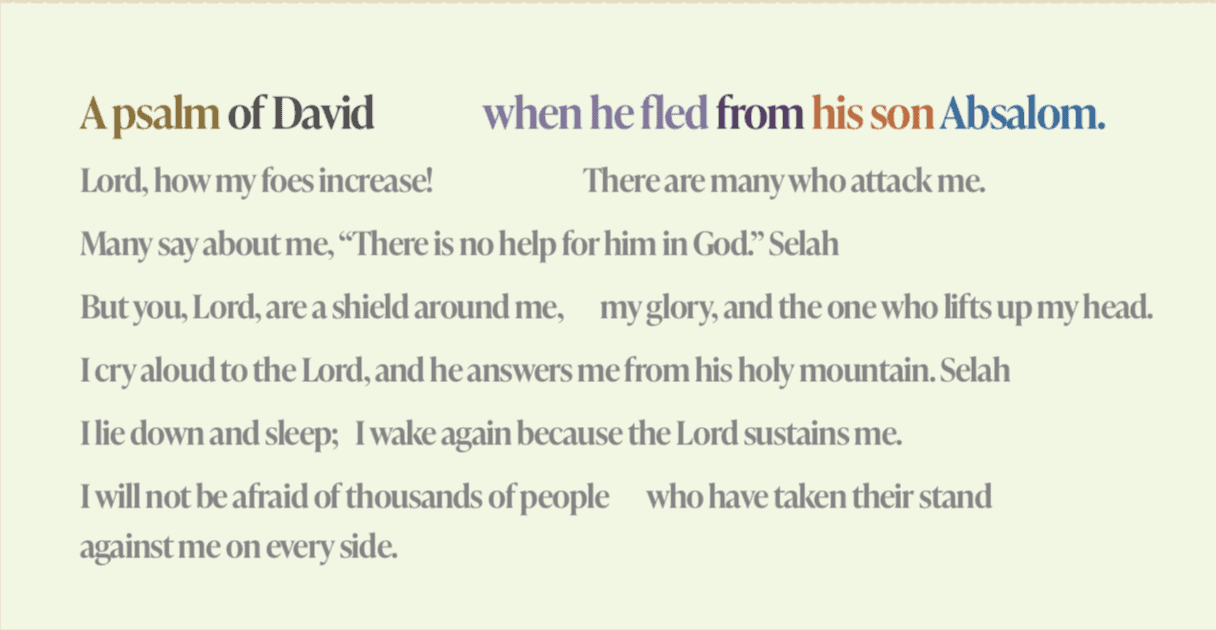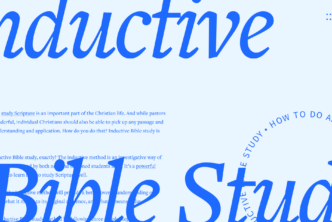Many of the 150 canonical psalms have superscriptions or titles, like: “Of David,” “For the choirmaster,” and “According to the lilies.” Are these superscriptions in the psalms original? Or were they added at a later time?
In this excerpt adapted from Bible Study Magazine, Peter J. Gentry explores the evidence in the manuscripts, the meaning of the most common superscription, whether we should consider the titles part of inspired Scripture—and how we can benefit from the titles in our interpretation of the psalms.1
***
Most English Bibles display the superscriptions in fine print. This suggests to the modern reader that these superscriptions are secondary in some way. But this is not what we find in our best manuscripts. As far back as the famous and respected Aleppo Codex (ca. AD 930), carefully written Hebrew Bibles display poetry in couplets—that is, pairs of lines separated by spacing or accents. Although the psalm superscriptions sometimes appear centered over the first pair of lines, they usually form the first line or even pair of lines in the psalm. Either way, tiny accent marks in the text indicate that the superscriptions either are verse 1 or are part of verse 1 in each psalm. The superscriptions are not written in smaller script as if they are somehow secondary to the biblical text.
In the Masada Psalms Scroll (MasPsa) from the late first century BC, the layout, spacing, and writing of the psalm titles match that of the Aleppo Codex precisely.2So, the tradition in the Aleppo Codex goes back to our earliest manuscripts. In some Dead Sea Scrolls, the psalms are written as prose and not laid out in parallel lines (for example, 11QPsa). Even in such manuscripts, the titles are always the first part of the psalm text in normal writing. Yet again, there is no indication that they are secondary or added later.


‘Of David’
Scholars have long debated the meaning of the Hebrew phrase ledawid, which is found in 84 superscriptions—just over half of the psalms. Could it mean “for (the reigning descendant of) David?”
Likely the most natural meaning of the phrase ledawid is “of David” (le = of; dawid = David), in the sense of “belonging to.” This could mean belonging to a Davidic psalm collection or belonging to David,
in the sense that he is the author. The use of the same le preposition in Isaiah 38:9 and Habakkuk 3:1 shows that authorship is grammatically possible; these verses attribute authorship to Hezekiah and Habakkuk respectively (many scholars, even if they disregard these titles, believe that the Masoretic scribes who gave us the Hebrew Bible intended to communicate Davidic authorship through these titles).
There is more evidence to consider: 2 Samuel 22 and Psalm 18 record the same psalm, and the title in 2 Samuel 22:2 clearly states that “David spoke [these words] to Yahweh.” So ledawid in Psalm 18 must mean “belonging to David” as the author. Also, psalm titles with historical notes contain information that support David’s authorship (for example, Ps 51:1–2). There are many verses concerning David’s poetic gifts and his interest in the liturgy. Finally, and importantly, the New Testament interprets the titles this way (Matt 22:43, 45; Mark 12:36, 37; Luke 20:42; Acts 1:16; 2:25; 4:25; Rom 4:6; 11:9; Heb 4:7). The same le preposition is prefixed to Solomon (Pss 72, 127), Moses (Ps 90), Asaph (12 times), Heman the Ezrahite (Ps 88), Ethan the Ezrahite (Ps 89), and the sons of Korah (11 times). These are all best understood in terms of authorship. This uniformity is not contradicted by the phrase “for the choir director,” for there the le preposition does not function in the same way, as is clear from the structure of the titles (see below).
Some have argued that, because the psalms speak of the temple, the poet could not be David, for the temple was not yet built in his time. Note, however, that both “house of Yahweh” (1 Sam 1:7; 3:15) and “temple” (1 Sam 1:9; 3:3) are used in the narrative of Hannah during the time of the judges, and there was no temple then, either. These terms, then, can refer to the institution rather than the building. Scholars have also argued that some Aramaic expressions in the Psalms are evidence of a later date for their composition. But the same mixture of Hebrew and Aramaic in Psalm 139, attributed to David, is also displayed in the Panammu and Zenjirli inscriptions of the ninth century BC. This cannot be an argument for a late date.
The reliability of the superscriptions in the psalms
The majority of scholars from 1880 to 1990 were skeptical about the age and the value of the psalm superscriptions. However, it is mischievous to pit historical method against linguistic, literary, and theological methods. Elsewhere in the ancient Near East, hymns have superscriptions and subscriptions.3
Titles are frequently lacking in the latest psalms, such as the post-exilic Psalm 137. Authorship is clearly given in Exodus 15; 2 Samuel 1, 22; Habakkuk 3; and Isaiah 38:9. If there was a tendency to add titles at a later time, why do we have so many orphan psalms—psalms with no title?4Why would later editors introduce material into the title not found in the historical books or readily inferred from the psalm itself (see Pss 7; 30; 60)? And if the psalm titles were added at a later date, why were they not understood by those who translated the ancient versions? Phrases like “for the choir director” (or “leading musician”) were actually misunderstood by both the Greek translators of the Septuagint (ca. 200 BC) and the later Jewish revisers like Theodotion, Aquila, and Symmachus (ca. AD 150). They interpreted the term according to its meaning in post-biblical Hebrew.
If the titles were added later, the language would not have been obscure to them. But instead, the language in the titles was already archaic and obscure by the second century BC. Similarly, the rubrics of ancient Sumerian hymns are just as obscure to Sumerologists.
Using the Psalm superscriptions
Since the superscriptions in the psalms are part of the inspired text of Scripture, how can Christians make better use of them in Bible study?
First step: careful analysis. In a helpful publication, Daniel Bourguet demonstrates that the psalm titles have a consistent structure.
- The nucleus or core of these titles presents either the genre of the text (maskil = “contemplative,” shir = “song,” tehillah = “praise,” tepilla = “prayer,” mizmor = “psalm”), or the name of the author to whom the psalm is attributed (David, Asaph, Korah), or both pieces of information.
- The address, such as “to the choirmaster,” can precede or follow this core.
- Between the address and the nucleus, musical instructions occasionally appear. These focus on the instrumentation or the manner of playing: “on stringed instruments”; “on [the tune of ] the doe at dawn.”
- Following the nucleus, one sometimes finds liturgical instructions: “a psalm for the Sabbath day”; “a psalm of love.”
- There may also appear historical information: “when Nathan came to him because he went in to Bathsheba.”
Second step: consider what the superscription tells you about the context for and purpose ofwhatever psalm you are reading. The confessions of Psalm 51 mean far more because of the circumstances surrounding the psalm—David’s adultery with Bathsheba and his murder of Uriah. The superscription of Psalm 56 sheds light not only on the psalm but on the situation in 2 Samuel, which gave rise to it (you may wish to take a look for yourself ).
All evidence suggests that we should respect the psalm titles as part of the original text of the Psalter as a book. It is heartening to see recent scholars using the evidence in the titles to show what motivated the arrangement of the psalms as a book.
***
This excerpt was adapted from Peter J. Gentry’s article “Are Psalm Superscriptions Part of Scripture, or Are They Later Additions?” in the May/June edition of Bible Study Magazine, available from Lexham Press.
Related articles
- Pray for Enemies—and against Them? Lessons from the Psalms
- Tired of Whining about Today’s Calamities? Open the Psalms of Lament
- How to Use a Commentary to Study the Psalms
- Should Differences in Biblical Manuscripts Scare Christians?
Related resources
- Psalms of the Faithful: Luther’s Early Reading of the Psalter in Canonical Context by Brian T. German
- Psalms: Evangelical Biblical Theology Commentary (2 vols.) (EBTC) by James M. Hamilton
- Top resources on Psalms
- Gentry acknowledges the benefit of class notes from Bruce K. Waltke, Dallas Theological Seminary, 1976.
- Peter J. Gentry and John D. Meade, “MasPsa and the Early History of the Hebrew Psalter,” in From Scribal Error to Rewriting: How Ancient Texts Could and Could Not Be Changed, ed. Anneli Aejmelaeus, Drew Longacre, and Natia Mirotadze (Gottingen: Vandenhoeck & Ruprecht, 2020).
- James B. Pritchard, ed., Ancient Near Eastern Texts Relating to the Old Testament, 3rd ed. with supplement (Princeton: Princeton University Press, 1969), 365–81.
- E. W. Hengstenberg, Commentary on the Psalms, trans. John T. Leith and Patrick Fairbairn, 4th ed., vol. 3 (Edinburgh: T&T Clark, 1864), xxii–xxxi.







